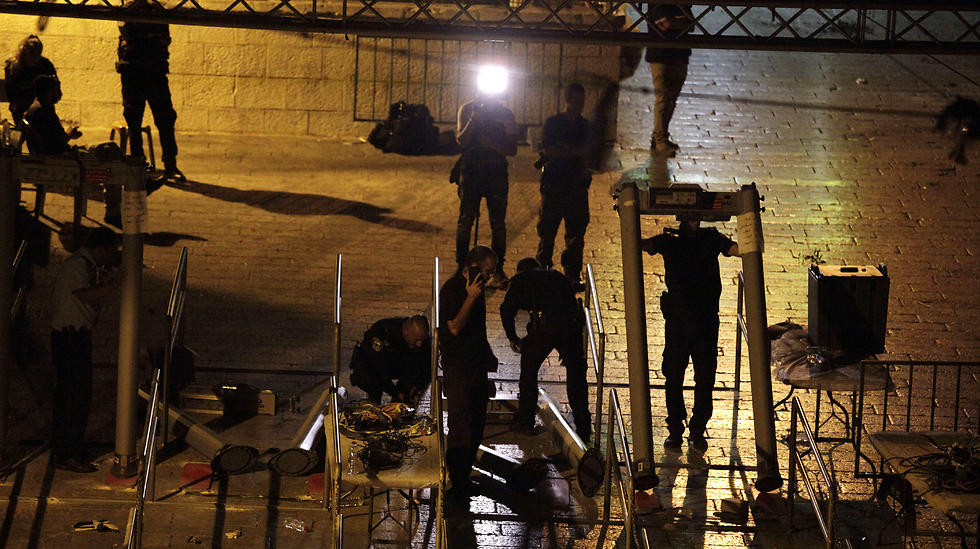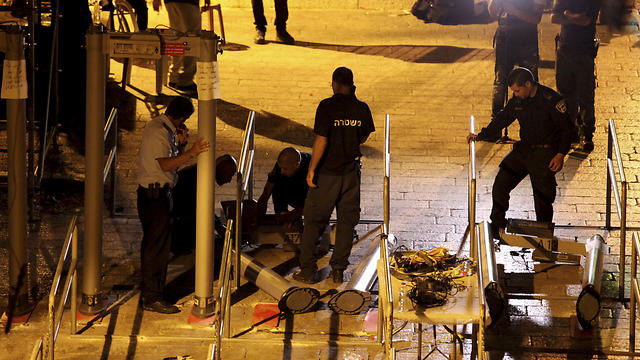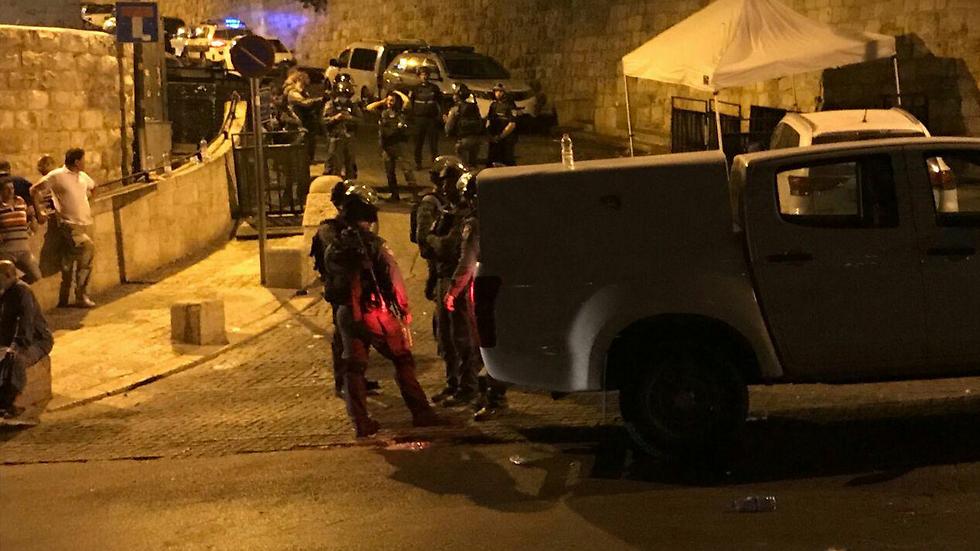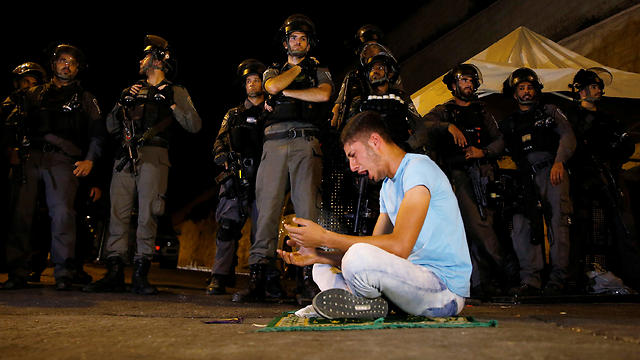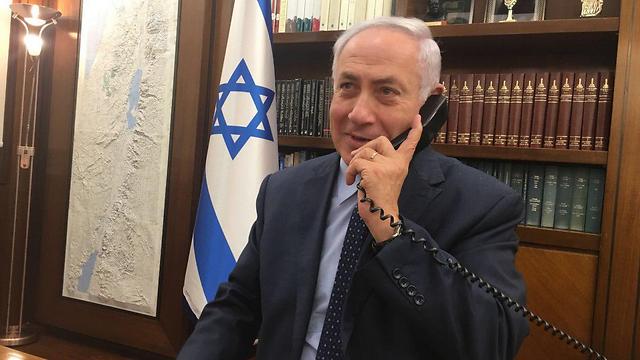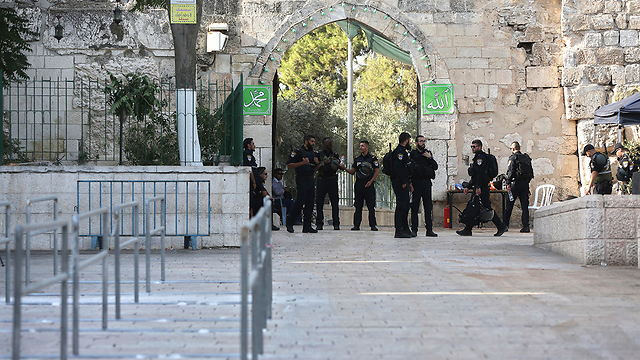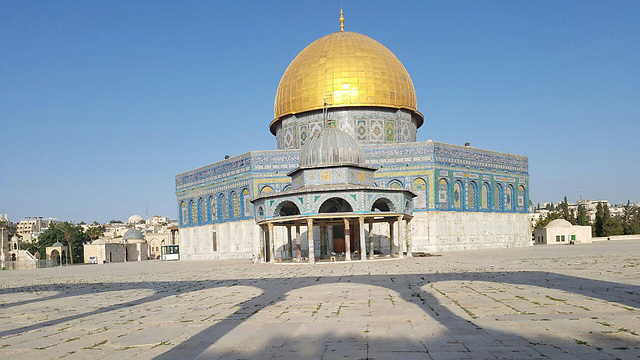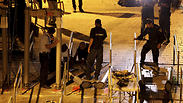
However, new details from the meeting reveal that in addition to the metal detectors, security cameras set up at the entrance to the Temple Mount will also be removed, effectively returning the site to the state leading up to the terror attack in which two police officers were murdered.
The process of removing the metal detectors from the sensitive site began overnight.
The timetable for the planned installation of the new "smart" inspection equipment is expected to be six months and has been allocated a budget of NIS 100 million.
According to the plan, until the new equipment has been installed, police presence in the area will be significantly increased in order to secure the area.
Before the meeting, one of the possible solutions to the replacement of the metal detectors was the installation of sophisticated, high-resolution cameras that include thermal systems and can detect concealed weapons or explosives as well as advanced facial recognition systems.
Worshippers who arrived at the Temple Mount on Tuesday morning indicated that they would not be willing to enter the compound until the cameras installed together with the metal detectors were removed. They also indicated that they are prepared to continue the struggle.
Meanwhile, Waqf officials are expected to convene to discuss the new procedures and the new replacements for the metal detectors.
Worshippers await instructions from the Waqf.
The decision to remove the metal detectors and cameras comes after a period of heightened tensions following a terrorist attack at the Temple Mount in which two police officers were murdered. The decision to erect the metal detectors was met with rioting and clashes from Arabs and Muslims in Israel and abroad.
The crisis reached a peak Monday when an Israeli embassy guard in Amman shot dead to two Jordanians in self defense after being attacked by one wielding a screwdriver, who managed to stab the guard twice before being shot and killed.
Security Cabinet discussion details
In light of the escalation, President Trump's Mideast envoy Jason Greenblatt was dispatched to the region to help reach a peaceful solution.
Greenblatt met with Prime Minister Benjamin Netanyahu on Monday before traveling to Jordan to finalize details of a plan that would have the metal detectors removed from the Temple Mount and the return of the Israeli embassy guard to Israel.
However, in the discussions, the removal of the metal detectors and cameras were not presented as being part of a deal to return the Israeli embassy guard from Amman. Participants in the discussion said it was clear that the matter was taken into consideration in order to end the diplomatic crisis with Jordan.
It has also been revealed that police were requested to formulate a plan in the past to erect metal detectors at the entrance to the Temple Mount. Following the terrorist attack in which officers Ha'il Satawi and Kamil Shnaan were murdered, it was decided to put the plan into motion.
It is worth noting however that police did not recommend erecting the metal detectors out of concern for provoking violence.
MK Bezalel Smotrich (Bayit Hayehudi) said the decision constitutes "capitulation and surrender to terrorism. The leadership folded and provided a victory for terrorism and violence.
"Leadership is tested by the ability to make good and long-term decisions even if they are not popular in the immediate future. Now the Arabs understand that the massacre of a Jewish family was worthwhile and would fold us. I am pleased to discover that ministers Bennett, Shaked and Elkin preferred the interest of security over populism and voted against the surrender."
MK Masud Ghnaim said that removal of the metal detectors is "a victory for the struggle and demonstrations of the Palestinian public, and a victory for the steadfastness of the religious leadership, the Waqf and the political leadership in Jerusalem in particular."
Commenting on the events since the attack on the Temple Mount, Ghnaim said, "The problem from the beginning was the Israeli government's attempt to exploit the incident on July 14 to establish new facts on the ground in area that is occupied territory. Anything new in the entrance or in the area of the mosque should be agreed upon, accepted by the religious and political leadership and by the Arab-Palestinian public."
MK Jamal Zahalka, chairman of the Joint List faction, condemned the placing of the cameras in front of the gates of the Al-Aqsa Mosque. "This is a new provocation by Netanyahu and another provocation to the worshipers who visit the mosque."
Zahalka welcomed the removal of the metal detectors and called for the return of control of the gates of al-Aqsa to the Muslim Waqf without electronic security measures. "Al-Aqsa and east Jerusalem are occupied territory and what applies to it is international law and not Israeli law."
US Ambassador to Israel David Friedman referred to US involvement in the Temple Mount crisis during a festive meeting of the Israel-US lobby in the Knesset. "There was a lot of hard work behind the scenes at the highest levels in the US and Israel, and with the Jordanian king," Friedmann said. "We managed to quickly neutralize a situation that could have ended otherwise. We work closely for our common interests."
The Temple Mount status quo
In recent years there have been changes in the status quo that was formulated following the Six Day War.
The original status quo prevented Jewish prayer on the Temple Mount, but allowed Jews to visit it. Today, Jews are often denied visits to the Mount or are severely restricted—especially during sensitive periods.
In the past, Jews were allowed to visit on Saturdays as well as inside the mosques, however today, such an arrangement is no longer possible.
After the Six Day War, the government determined that the laws of the State of Israel apply to the Temple Mount. Today, the situation has changed.
In practice, for many years the planning, construction and antiquities laws on the Temple Mount have not been fully enforced. The status quo has also granted Jordan involvement in the administration of the Temple Mount compound through the Waqf—an arm of the Jordanian Ministry of Religious Endowments.
Today the Jordanian influence on the Temple Mount has greatly expanded—even on the conduct of the Israel Police.
The ban on waving flags on the Temple Mount is enforced only when it comes to Israeli flags. Comparatively, during rallies and protests held on the Temple Mount, flags of various movements—sometimes even terrorist movements such as Hamas—are frequently raised.
The old status quo on the Temple Mount no longer exists. It changed significantly in a series of key parameters, in such a way that greatly improved the status of the Muslim side of the compound and greatly undermined the status of the Israeli-Jewish side.
However, one of the central components of the old status quo—prohibiting Jewish prayer on the Temple Mount—is strictly observed.















